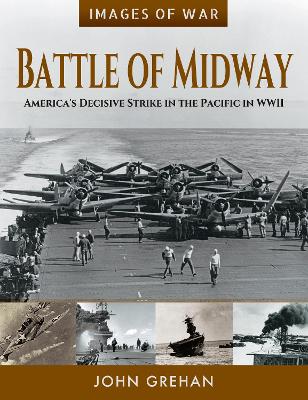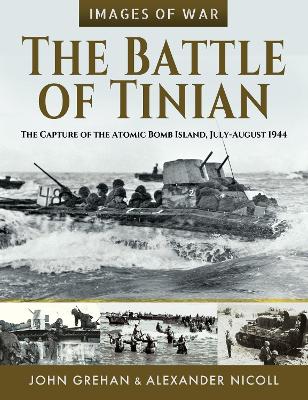Images of War
2 total works
Japan's attack on Pearl Harbor in the Hawaiian Islands on 7 December 1941, had severely damaged the United States Pacific Fleet but had not destroyed it, for the fleet's aircraft carrier force had been at sea when the Japanese struck. This meant that, despite the overwhelming success of Japanese military forces across the Pacific, US carrier-based aircraft could still attack Japanese targets.
After the Battle of the Coral Sea in early May 1942, in which both sides had lost one carrier, the commander of the Japanese Combined Fleet, Admiral Isoroku Yamamoto, calculated that the US had only two serviceable carriers left. If those remaining carriers could be lured into a battle with the Combined Fleet and destroyed, nothing could stop the Japanese achieving complete control of the South Pacific.
It would take the United States many months, even with its massive industrial muscle, to rebuild its carried fleet if it was destroyed, by which time Japan would be able to secure the raw materials needed to keep its war machine functioning and to build all the bases it required across the Pacific, which would enable its aircraft to dominate the entire region.
Aware of the sensitivity of the Americans towards Hawaii after the Battle of Pearl Harbor, Yamamoto believed that if he attacked there again, the US commander, Admiral Nimitz would be certain to commit all his strength to its defence. Yamamoto selected the furthest point of the Hawaiian Islands, the Naval Air Station on the Midway Atoll, for his attack, which was beyond the range of most US land-based aircraft.
Yamamoto launched his attack on 4 June 1942\. But the US had intercepted and deciphered Japanese signals and Nimitz, with three not two aircraft carriers, knew exactly Yamamoto's plans. Yamamoto had hoped to draw the US carriers into his trap but instead he sailed into an ambush.
The four-day battle resulted in the loss of all four Japanese aircraft carriers, the US losing only one. The Japanese were never able to recover from these losses, and it was the Americans who were able to take control of the Pacific. The Battle of Midway, unquestionably, marked the turning point in the war against Japan.
After the Battle of the Coral Sea in early May 1942, in which both sides had lost one carrier, the commander of the Japanese Combined Fleet, Admiral Isoroku Yamamoto, calculated that the US had only two serviceable carriers left. If those remaining carriers could be lured into a battle with the Combined Fleet and destroyed, nothing could stop the Japanese achieving complete control of the South Pacific.
It would take the United States many months, even with its massive industrial muscle, to rebuild its carried fleet if it was destroyed, by which time Japan would be able to secure the raw materials needed to keep its war machine functioning and to build all the bases it required across the Pacific, which would enable its aircraft to dominate the entire region.
Aware of the sensitivity of the Americans towards Hawaii after the Battle of Pearl Harbor, Yamamoto believed that if he attacked there again, the US commander, Admiral Nimitz would be certain to commit all his strength to its defence. Yamamoto selected the furthest point of the Hawaiian Islands, the Naval Air Station on the Midway Atoll, for his attack, which was beyond the range of most US land-based aircraft.
Yamamoto launched his attack on 4 June 1942\. But the US had intercepted and deciphered Japanese signals and Nimitz, with three not two aircraft carriers, knew exactly Yamamoto's plans. Yamamoto had hoped to draw the US carriers into his trap but instead he sailed into an ambush.
The four-day battle resulted in the loss of all four Japanese aircraft carriers, the US losing only one. The Japanese were never able to recover from these losses, and it was the Americans who were able to take control of the Pacific. The Battle of Midway, unquestionably, marked the turning point in the war against Japan.
At 02.45 hours on the morning of 6 August 1945, a Boeing B-29 Superfortress, named after the pilot's mother, Enola Gay, lifted off from a tiny island deep in the Pacific Ocean on one of the most important missions in human history. The B-29 carried just one bomb; the target was Hiroshima.
The dropping of the first atomic bomb on Hiroshima, and of a second nuclear device on Nagasaki three days later, is known throughout the world. But what is often forgotten is that these missions were only possible following the savage battles to seize the Northern Mariana Islands -which, crucially, were within the B-29's operational range of Japan. With the capture of these islands, the defeat of Hirohito's Imperial Japan became a certainty as for the first time in the war land-based heavy bombers could fly all the way to Tokyo and back.
The sparsely-populated island of Tinian was turned into the biggest air base in the world. With six runways, four of which were built for the huge Superfortresses, it was from there that atomic destruction of Japan began.
But, before all this, had been the battle for the island -the preliminary naval bombardment, the aerial strikes and the amphibious assault. The story of that battle is told here, in the words and images of the men who took part in that memorable, and ultimately epoch-changing, campaign.
Part of this is another story, that of the warship USS Indianapolis. This Portland-class heavy cruiser was handed a secret mission �of the utmost significance to national security', that of taking the enriched uranium and other vital parts of the atomic weapons to Tinian. Indianapolis succeeded in its mission, but was left to return to Pearl Harbor unescorted, resulting in one of the most unfortunate and gristly episodes in US maritime history.
Few stories encapsulate human endeavour, achievement, sacrifice, and failure in quite such stark contrasts as the taking of the island of Tinian, once the centre of USAAF operations in the Pacific and now just a little-visited speck in the largest ocean in the world.
The dropping of the first atomic bomb on Hiroshima, and of a second nuclear device on Nagasaki three days later, is known throughout the world. But what is often forgotten is that these missions were only possible following the savage battles to seize the Northern Mariana Islands -which, crucially, were within the B-29's operational range of Japan. With the capture of these islands, the defeat of Hirohito's Imperial Japan became a certainty as for the first time in the war land-based heavy bombers could fly all the way to Tokyo and back.
The sparsely-populated island of Tinian was turned into the biggest air base in the world. With six runways, four of which were built for the huge Superfortresses, it was from there that atomic destruction of Japan began.
But, before all this, had been the battle for the island -the preliminary naval bombardment, the aerial strikes and the amphibious assault. The story of that battle is told here, in the words and images of the men who took part in that memorable, and ultimately epoch-changing, campaign.
Part of this is another story, that of the warship USS Indianapolis. This Portland-class heavy cruiser was handed a secret mission �of the utmost significance to national security', that of taking the enriched uranium and other vital parts of the atomic weapons to Tinian. Indianapolis succeeded in its mission, but was left to return to Pearl Harbor unescorted, resulting in one of the most unfortunate and gristly episodes in US maritime history.
Few stories encapsulate human endeavour, achievement, sacrifice, and failure in quite such stark contrasts as the taking of the island of Tinian, once the centre of USAAF operations in the Pacific and now just a little-visited speck in the largest ocean in the world.

